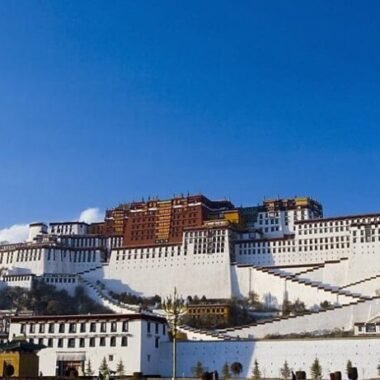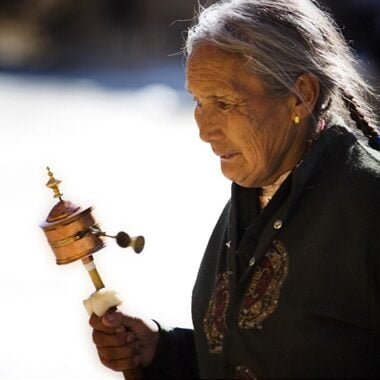Influence of Tibetan Buddhism on the Daily Life of Tibetans
The Influence of Tibetan Buddhism on the Daily Life of Tibetans Tibetan Buddhism is not only a religion in Tibet; it is…
The Influence of Tibetan Buddhism on the Daily Life of Tibetans
Tibetan Buddhism is not only a religion in Tibet; it is a fundamental part of the Tibetan identity, shaping every aspect of daily life for the people of this land. From their worldview to their social customs, Tibetan Buddhism deeply influences the routines, values, and traditions of the Tibetan people.
Spiritual Practices and Daily Rituals
One of the most evident influences of Tibetan Buddhism on daily life is the widespread practice of spiritual rituals. Tibetans begin and end their days with prayer, either through chanting mantras, performing prostrations, or lighting butter lamps. Prayer wheels, often found in Tibetan homes and monasteries, are turned as a means of accumulating merit and seeking blessings. Many Tibetans also wear malas, prayer beads, to help maintain mindfulness and recite mantras throughout the day.
In rural areas, it is common to see Tibetans walking around their homes or local temples while turning prayer wheels or prostrating themselves to accumulate spiritual merit. Pilgrimages to sacred sites like Mount Kailash, Lhasa, or other important monasteries are considered not only a religious obligation but also a profound spiritual journey that can be undertaken during major life events, such as birthdays or after important milestones.
Influence on Family and Social Structure
Tibetan Buddhism strongly influences family dynamics and social structures. Respect for elders is deeply rooted in Buddhist teachings, and it is considered a virtue to care for one’s parents, particularly in old age. Family life is often centered around communal activities such as prayer, meditation, and sharing spiritual teachings.
Monasticism plays a significant role in Tibetan society. Many Tibetans send their children to monasteries to receive spiritual education. Some families may even dedicate one child to monastic life, believing it to be a noble calling. This practice not only nurtures spiritual knowledge but also creates a close-knit community that shares common values, where monasteries serve as both religious centers and social hubs.
Festivals and Ceremonies
Tibetan Buddhism also determines the rhythm of the year through numerous religious festivals and ceremonies. Key events such as Losar (Tibetan New Year), Saga Dawa, and the Butter Lamp Festival are deeply rooted in Buddhist tradition and are celebrated with rituals, prayers, and family gatherings. During these festivals, Tibetans dress in traditional attire, engage in religious rituals, and offer prayers to the deities for health, prosperity, and the well-being of their families.
Marriage ceremonies, funerals, and even birth celebrations are often intertwined with Buddhist practices. For example, during a wedding, monks may be invited to perform blessings, and family members may gather to pray for a harmonious and prosperous life together. Similarly, funerals are marked by rituals that ensure the peaceful journey of the deceased’s soul into the next life, guided by Tibetan Buddhist principles of reincarnation.
Architecture and the Physical Environment
Tibetan Buddhist architecture significantly impacts the way Tibetans build their homes and villages. Tibetan homes, particularly those in rural areas, are often constructed with the direction of the sun in mind and designed to reflect a deep respect for the natural world, which is integral to Buddhist philosophy. The placement of Buddhist symbols like stupas or statues of deities in homes and communities reinforces spiritual connections to the divine.
Monasteries, with their intricate designs and symbolic colors, are central to Tibetan villages and towns. They are not only places of worship but also serve as cultural and educational institutions. The presence of stupas and prayer flags, which dot the landscape, is another daily reminder of Buddhism’s significance in the Tibetan way of life.
Tibetan Buddhism and Tibetan Medicine
Tibetan Buddhism also influences Tibetan traditional medicine, which is based on the belief that physical health, mental well-being, and spiritual harmony are interconnected. Many Tibetans seek guidance from monks or spiritual leaders for healing, in addition to visiting medical practitioners. Rituals, meditation, and prayer are considered essential components of the healing process, along with the use of herbs and physical therapies.
Conclusion
Tibetan Buddhism’s influence on daily life is far-reaching, shaping not only individual spiritual practices but also family structures, social norms, festivals, architecture, and even health practices. It is a way of life that integrates the physical, mental, and spiritual realms, ensuring that Tibetans live in harmony with their faith, community, and environment. Through Tibetan Buddhism, Tibetans find meaning in their existence, and it continues to guide them through the complexities of modern life while preserving ancient traditions.











